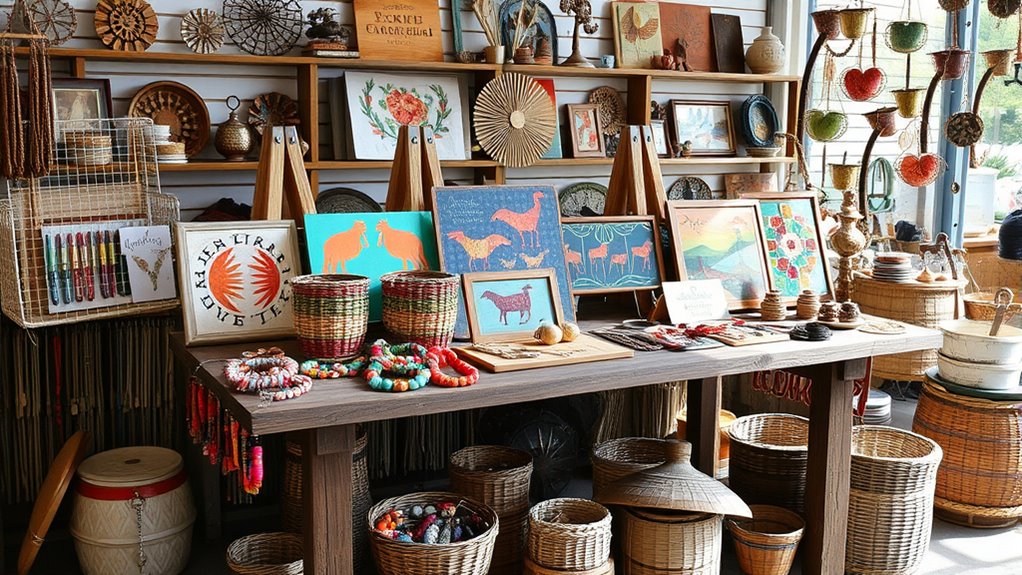To turn shop scraps into high-margin craft fair goods, see every scrap as a chance to create unique, eco-friendly items that attract conscious buyers. Repurpose fabric, wood, or metal scraps into pouches, jewelry, or decor, and highlight their sustainable origins through attractive packaging and storytelling. Price your creations based on craftsmanship and their eco-value, and showcase the transformation process to build interest. Keep exploring these tips to discover more ideas for profitable, eco-conscious crafts.
Key Takeaways
- Repurpose scraps into unique handcrafted items like jewelry, pouches, or decor to add value and appeal at craft fairs.
- Use creative finishing touches and vibrant colors to make scrap-based products visually attractive and marketable.
- Highlight the eco-friendly story behind your items to justify premium pricing and attract environmentally conscious buyers.
- Package products attractively with labels emphasizing sustainability and craftsmanship to enhance perceived value.
- Share your creative process and story to engage customers and build loyalty around your eco-friendly, handcrafted goods.

Transforming leftover scraps into beautiful craft fair goods is a rewarding way to turn trash into treasure. When you’re working with scraps, mastering recycling techniques is essential to maximize their potential. Think of your scraps not as waste but as raw materials waiting for a creative touch. For example, fabric scraps can be sewn into small pouches or appliqué accents, while pieces of wood or metal can be repurposed into jewelry or decorative items. The key lies in understanding how to efficiently repurpose different materials, which not only reduces waste but also creates unique, handcrafted products that stand out at craft fairs. As you develop your recycling techniques, you’ll discover which scraps lend themselves best to specific projects, streamlining your process and boosting your productivity. Incorporating color accuracy into your designs can help ensure your finished products display vibrant, appealing visuals that attract buyers.
Once you start transforming scraps into finished goods, it’s *imperative* to establish effective pricing strategies. Your goal is to reflect the value of your craftsmanship while ensuring your efforts are financially worthwhile. When pricing, consider the cost of materials, the time you’ve invested, and the uniqueness of each piece. Because you’re working with scraps, your material costs are low, but don’t undervalue your labor or creativity. Instead, position your pricing to highlight the handmade quality and eco-friendly appeal of your products. For example, a small jewelry piece made from recycled metal might be priced higher than mass-produced alternatives, emphasizing its sustainability and artisanal charm. You can also leverage the story behind your scraps—customers are often willing to pay a premium for items that showcase environmental consciousness and individuality. Experiment with different pricing strategies, such as tiered pricing or bundle deals, to attract a wider range of buyers and increase your profit margins.
As you refine your recycling techniques and pricing strategies, keep in mind that presentation plays a *crucial* role in sales. Well-packaged items with clear descriptions about their eco-friendly origin tend to attract more attention and justify higher prices. Use attractive labels or tags to tell your story, emphasizing the transformation of scraps into art. Additionally, offering limited-edition or one-of-a-kind products can create a sense of exclusivity, encouraging customers to purchase on impulse. Remember, the way you market your craft fair goods can *considerably* impact your success. Highlight the sustainable aspect of your products, share the creative process, and connect with buyers who value environmental responsibility. By integrating clever recycling techniques with strategic pricing, you’ll turn your shop scraps into highly desirable craft fair goods that generate high margins and foster a loyal customer base.
Frequently Asked Questions
What Tools Are Best for Transforming Scraps Into Craft Items?
When transforming scraps into craft items, you’ll want versatile tools like scissors, rotary cutters, and hot glue guns. These help you implement recycling techniques efficiently. Make certain to maintain your tools regularly to keep them sharp and safe. Using the right tools and practicing proper tool maintenance will boost your productivity and ensure your projects turn out professional, making your craft fair goods truly stand out.
How Can I Price My Upcycled Craft Fair Products Effectively?
It’s a coincidence how pricing strategies can make or break your craft fair success. To price your upcycled products effectively, consider your material costs, labor, and target profit margins. Research what similar items sell for and factor in your unique value. Remember, balancing affordability with fair profit margins encourages sales while ensuring your effort pays off. This way, you turn each piece into a profitable, well-loved item.
Are There Specific Craft Fair Regulations for Handmade Scrap-Based Goods?
You should check your local craft fair regulations to guarantee compliance with safety standards and any specific rules for handmade scrap-based goods. Some events require product labeling, safety testing, or restrictions on certain materials. By understanding these regulations, you can avoid disqualification or fines. Always verify with the event organizers beforehand, so your upcycled items meet all safety standards and regulations compliance, making your craft fair experience smoother and more successful.
What Are Some Eco-Friendly Packaging Ideas for My Crafted Products?
When considering eco-friendly packaging for your crafted products, you should focus on using recyclable materials and compostable packaging options. These choices help reduce waste and appeal to environmentally conscious customers. You can opt for biodegradable wraps, paper-based fillers, or reusable containers. By prioritizing sustainable packaging, you not only protect the environment but also enhance your brand’s image, making your products more attractive at craft fairs.
How Do I Market My Scrap-Based Crafts to Stand Out?
To make your scrap-based crafts stand out, focus on social media promotion by showcasing your creative process and unique pieces. Share customer storytelling to highlight how your eco-friendly approach makes a difference. Use eye-catching photos and engaging captions to attract attention. Encourage satisfied customers to post reviews and tag your shop. This builds authenticity and community, helping your crafts gain visibility and appeal to eco-conscious buyers.
Conclusion
Now that you know how to transform your scraps into beautiful craft fair goods, it’s time to turn those leftover bits into gold. Think of your scraps as a treasure chest just waiting to be opened—each piece holding the potential for profit and creativity. With a little imagination and effort, you’ll be turning trash into treasure, making your booth stand out like a shining jewel among the crowd. Your craft fair success is just a scrap away!









